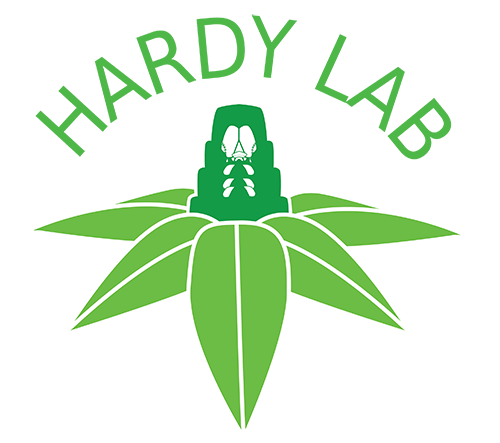Valid Names Results
Kermes spatulatus Balachowsky, 1953 (Kermesidae: Kermes)Nomenclatural History
- Kermes spatulatus Balachowsky 1953f: 184-186. Type data: ISRAEL: Daphne Oaks, Horshat Tal Nature Reserve, on Quercus ithaburensis, 12/05/1952, by H. Bytinski-Salz. Syntypes, female, Type depository: Paris: Museum National d'Histoire naturelle, France; accepted valid name Notes: There are 7 syntypes on 7 slides in the MNHN (Matile-Ferrero, personal communication, December 2, 1999). Illustr.
- Kermococcus spatulatus (Balachowsky, 1953); Borchsenius 1960d: 36. change of combination Notes: Ferris, 1921: 157 rejected the Silvestri substitution of Kermococcus for Kermes as not justified under the International Code and considered it a synonym. Borchsenius used Kermococcus as a proper replacement.
Common Names
Ecological Associates
Hosts:
Families: 1 | Genera: 1
- Fagaceae
- Quercus ithaburensis | Balach1953f SpodekBeMe2014
Foes:
Families: 2 | Genera: 2
- Encyrtidae
- Psilophrys ghilarovi | JaposhSpBe2015
- Psilophrys parvulus | JaposhSpBe2015
- Psilophrys tenuicornis | JaposhSpBe2015
- Eulophidae
- Aprostocetus bendovi | JaposhSpBe2015
Associates:
Families: 1 | Genera: 2
- Formicidae
- Crematogaster lorteti | SpodekMeBe2016
- Liometopum microcephalum | SpodekMeBe2016
Geographic Distribution
Countries: 2
- Iran | PourjaVaDa2023
- Israel | Balach1953f SpodekBeMe2014
Keys
- MoghadWa2024: pp.142 ( Adult (F) ) [Species of Kermes in Iran]
- Hodgso2020: pp.153-154 ( Adult (M) ) [Kermesidae]
- SpodekBe2014: pp.7 ( Adult (F) ) [Key to the adult females of Kermesidae species of Israel]
- SpodekBe2014: pp.7-8 ( Third instar (F) ) [Key to the third-instar females of Kermesidae species of Israel]
- SpodekBe2014: pp.8 ( Second instar (F) ) [Key to the second-instar females of Kermesidae species of Israel]
- SpodekBe2014: pp.8 ( First instar ) [Key to the first-instar nymphs of Kermesidae species of Israel]
- SpodekBe2014: pp.8 ( Adult (F) ) [Key to the post-reproductive females of Kermesidae species of Israel]
- SpodekBe2014: pp.8-9 ( Adult (M) ) [Key to the adult males of Kermesidae species in Israel]
- SpodekBe2014: pp.9 ( Second instar (M) ) [Key to the second-instar males of Kermesidae in Israel]
- Borchs1960d: pp.36 ( Adult (F) ) [Species of Kermococcus] Key as: Kermococcus spatulatus
Remarks
- Systematics: The first-instar nymph and post-reproductive female are morphologically similar to K. bacciformis Leonardi, a Mediterranean and European kermesid (Balachowsky, 1953f). Kermes spatulatus was described by Balachowsky (1953) based on first-instar nymphs collected in Israel. A redescription by Spodek & Ben-Dov (2014), includes several features not originally described, such as presence of: (i) dorsal microtubular ducts in four longitudinal rows; (ii) a complete submarginal row of setae on venter; (iii) a single bilocular pore located submarginally level with each spiracle on venter; (iv) a denticle near tip of each claw; (v) one setose seta mesad to each coxa; (vi) anal ring open both posteriorly and anteriorly; and (vii) microspines on abdominal segments on venter.
- Structure: Adult female is similar to Kermes bacciformis both in coloration and form (Balachowsky, 1953f). Adult females of K. spatulatus and of K. nahalali have two brood chambers. Field characters (measurements from Spodek & Ben-Dov 2014): Pre-reproductive adult female oval to round, 2.0–4.0 mm long, 1.4–3.4 mm wide and 1.4–2.5 mm high; dorsum and venter dark grey to black, with 13–15 dark spots on dorsum in 8 longitudinal rows from anal opening to anterior apex. Post-reproductive female spherical and sclerotized, 5.2–6.0 mm long, 4.9–5.6 mm wide and 3.0–5.0 mm high; black, sometimes with medial longitudinal groove and each half of body with 4 transverse grooves. Venter with 2 brood chambers (Moghaddam & Watson, 2024).
- Biology: This species is bi-parental and univoltine. (Spodek, et al., 2014)
- General Remarks: Description and illustration by Balachowsky (1953f). Detailed descriptions, photographs and illustrations of first instar nymphs, second, third instar and adult females as well as second instar, pupa and adult males in Spodek & Ben-Dov, 2014.
Illustrations
Citations
- Balach1953f: description, distribution, host, illustration, taxonomy, 184-186
- BenDov2012: catalog, distribution, host, 33, 42
- Borchs1960d: distribution, host, illustration, taxonomy, 27, 36, 73, 76
- BytinsSt1967: distribution, host, 126
- Hodgso2020: key, 153
- Hoy1963: catalog, distribution, host, taxonomy, 161
- Hu1986X: distribution, 300
- JaposhSpBe2015: natural enemies,
- KozarDr1998h: catalog, distribution, host, taxonomy, 412
- KozarWa1985: catalog, distribution, 76
- MoghadWa2024: diagnosis, distribution, history, host, illustration, key, 10, 16, 18, 143-145
- PellizPoCo2012: distribution, host, taxonomy, 38
- PorcelPe2014: taxonomy, 61
- PourjaVaDa2023: description, distribution, host, illustration, nymph, taxonomy,
- SpodekBe2012: distribution, taxonomy, 12
- SpodekBe2014: description, distribution, host, illustration, phylogeny, taxonomy, 65-79
- SpodekBeGh2012: distribution, 25
- SpodekBeMe2014: distribution, host, illustration, life history, 109, 116, 117
- SpodekBePr2012: distribution, 67
- SpodekMeBe2016: ant association, host, illustration, life history, life cycle, phenology, 1433-1446
- Sternl1969: host, taxonomy, 251, 252, 235
- Ziderm1986: chemistry, 419


